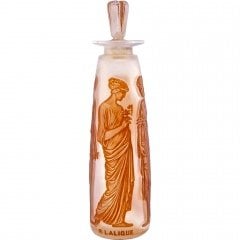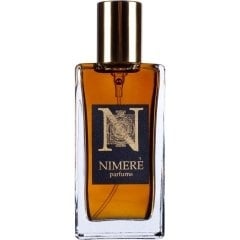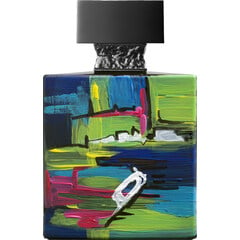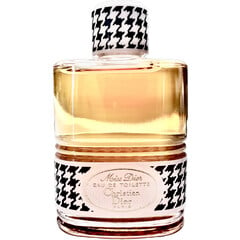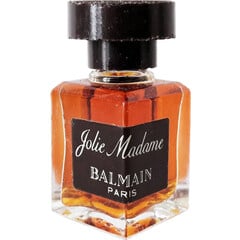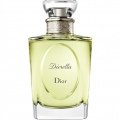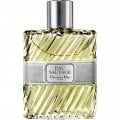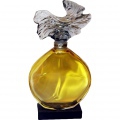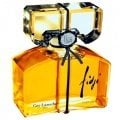
Gold
Reviews
Filter & sort
Translated
Show original
François Coty, the innovator
François Spoturno, a Corsican, loses his parents very early and is brought up by his grandmother. When he is 13 years old, she no longer has enough money to pay for his school, but this does not diminish François' ambition. In 1900 he went to Paris and became the personal secretary of the politician Emmanuel Arène. François saw how Parisian companies were preparing for the forthcoming Universal Exhibition and happened to meet the pharmacist Raymond Goëry, who took him to a perfumers' event. Although François has no previous knowledge of chemistry or perfume, he is so fascinated by the subject that he spends all his free time in Goëry's laboratory.
This Goëry produces a traditional Eau de Cologne that François mixes in his experiments with other perfumes of the period, with scents that seem to him somehow unimaginative and lame.
And soon he makes the courageous decision to study chemistry, so he moves to Grasse. Here he works with the Chrisis laboratory and learns how to combine natural and synthetic ingredients to create a new fragrance.
To start his own business, François borrowed money from his grandmother and changed his name to Coty, which was his mother's maiden name.
He opens his first shop in the Rue de la Boétie. François has neither the capital nor the experience of the established perfume companies, but he has one decisive advantage: his unconditional will to innovate
It is precisely because he is still completely unknown that he is able to defy all style guidelines and win over new, broader groups of buyers beyond the nobility and the rich bourgeoisie. He wanted to create new perfumes for all women and his first fragrance, "La Rose Jacqueminot", 1904, was already a success. In 1905, he launched "L'origan", and also "Ambre Antique", which will be discussed in more detail later
"Ambre Antique" seduces not only by its perfectly balanced mixture of floral and spicy notes on a base of vanilla and musk, but also by its outward appearance.
Coty is revolutionizing not only the way fragrances are created, but all other areas of production as well. It's also extremely clever when it comes to packaging and marketing.
"Un parfum se regarde autant qu'il se sent", Coty's motto still applies today.
Coty began working with René Lalique in 1910: Coty's sales figures are rising and rising.
In 1923, François Coty was a powerful industrialist, one of the most important entrepreneurs in France. He even acquires the newspaper "Le Figaro"
Until his death in 1934, he was a major revolution in the perfume industry, a true "self-made man".
Others move to :
The former general manager of Coty, Armand Petitjean, founded his own company in 1935 and called it Lancôme...
Who, what, how... etc. belongs to today and which corporations are dividing up the cake in the 21st century, I don't want to break down here.
I wanted to tell a little bit about the career of the great Coty, whose "Ambre Antique" I unfortunately do not have in my collection. However, I was allowed to test the fragrance (a thousand thanks to Gandix, whose vintage collection is extraordinary!!!) and I am completely thrilled. It reminds me of "Obsession" by Calvin Klein, but in a "finer version" - maybe this comparison helps to imagine the fragrance.
Just to experience all the works of the great François Coty in their beauty, it is worth visiting the Osmothèque in Versailles. Or perhaps a detour to Gandix?
This Goëry produces a traditional Eau de Cologne that François mixes in his experiments with other perfumes of the period, with scents that seem to him somehow unimaginative and lame.
And soon he makes the courageous decision to study chemistry, so he moves to Grasse. Here he works with the Chrisis laboratory and learns how to combine natural and synthetic ingredients to create a new fragrance.
To start his own business, François borrowed money from his grandmother and changed his name to Coty, which was his mother's maiden name.
He opens his first shop in the Rue de la Boétie. François has neither the capital nor the experience of the established perfume companies, but he has one decisive advantage: his unconditional will to innovate
It is precisely because he is still completely unknown that he is able to defy all style guidelines and win over new, broader groups of buyers beyond the nobility and the rich bourgeoisie. He wanted to create new perfumes for all women and his first fragrance, "La Rose Jacqueminot", 1904, was already a success. In 1905, he launched "L'origan", and also "Ambre Antique", which will be discussed in more detail later
"Ambre Antique" seduces not only by its perfectly balanced mixture of floral and spicy notes on a base of vanilla and musk, but also by its outward appearance.
Coty is revolutionizing not only the way fragrances are created, but all other areas of production as well. It's also extremely clever when it comes to packaging and marketing.
"Un parfum se regarde autant qu'il se sent", Coty's motto still applies today.
Coty began working with René Lalique in 1910: Coty's sales figures are rising and rising.
In 1923, François Coty was a powerful industrialist, one of the most important entrepreneurs in France. He even acquires the newspaper "Le Figaro"
Until his death in 1934, he was a major revolution in the perfume industry, a true "self-made man".
Others move to :
The former general manager of Coty, Armand Petitjean, founded his own company in 1935 and called it Lancôme...
Who, what, how... etc. belongs to today and which corporations are dividing up the cake in the 21st century, I don't want to break down here.
I wanted to tell a little bit about the career of the great Coty, whose "Ambre Antique" I unfortunately do not have in my collection. However, I was allowed to test the fragrance (a thousand thanks to Gandix, whose vintage collection is extraordinary!!!) and I am completely thrilled. It reminds me of "Obsession" by Calvin Klein, but in a "finer version" - maybe this comparison helps to imagine the fragrance.
Just to experience all the works of the great François Coty in their beauty, it is worth visiting the Osmothèque in Versailles. Or perhaps a detour to Gandix?
31 Comments
Translated
Show original
When time stood still
Nikolaj Jerjomin, the owner and creative head of Nimère, has been producing niche fragrances in St. Petersburg for several years now that truly deserve this name. I became aware of him through LadyLuxifer, who maintains a good personal contact with Nikolaj and has introduced me to his fragrances, for which I am very grateful to her.
Nikolaj has created over 40 different perfumes so far and all of the perfumes I have been able to test so far have been of excellent quality.
At Nimère, no expense is spared, the fragrances are not minimalist, breathy, transparent waters, but strong, expressive perfumes with a very long shelf life. It's against this background that you can understand the relatively high prices that Nimère charges for its perfumes. They're not eaux de toilettes, but rather concentrated extracts.
That's why even a 5 ml mini-bottle is enough to keep one of the wonderful Nimère perfumes for a long time. In the case of "Time stood still", a single splash is enough to get you through the day or night in a fragrant way.
Incidentally, in September Jerjomin gave an interesting interview to an employee of Fragrantica. ru, in which he explains - as always much too modestly - that he does not want to call himself a real perfumer and that he pursues many other interests in life besides creating fragrances. At the moment, he says, astrology has taken a liking to him. Moreover, he doesn't want to compulsively create new perfumes all the time, but is of the opinion that with his collection of more than 40 fragrances he already has a very extensive work that should be enjoyed. a very sympathetic and clever approach, in my opinion, because
after all, behind every perfume from Nimère lies a certain artistic concept, which took a lot of strength and energy to develop. The results are individual, impressive fragrances that offer new fragrance experiences beyond the mainstream.
---
"Time stood still"
'When you were born,
everyone laughed even though you cried.
Live so that when you take your leave,
all cry,
although you're smiling. '
My father wrote these words to me in my poetry album when I was eight years old. It is a poem by Omar Khayyam, which my father translated for me in the wording given here.
When my father died, time stood still for me for a few seconds.
"The fire in your eyes keeps me alive and the fire in your eyes... keeps me alive, keeps me alive..." -
again and again I hear the song "Sanctuary" by The Cult.
When I was first infected by the fire in the deep brown eyes of my beloved man, time stood still for a few seconds.
"When the wind blows from the Neva, Yekaterina looks out the window... ...there they run, the young lions"...
again and again I have to think of my meeting with Boris Grebenshikov, one of the greatest Russian singer-songwriters, whom I met in 1992 and at whose concert in a small circle in the house of a good friend time stood still for me for a few seconds.
You don't wear "Time stood still" for others, you wear it for yourself.
It begins quite fresh with a touch of lavender, but quickly becomes pleasantly balsamic. Spicy, warm notes of nutmeg, ambergris and corkuma combine with frankincense and golden brown honey. Here everything is so finely woven together that it seems impossible to separate one note from the other.
A certain comforting sweetness paired with a delicate smokiness invite you to meditate, to let yourself go.
A perfume that can bring back unforgettable moments when time stood still for you.
A real gift.
Спасибо тебе, Николай.
Nikolaj has created over 40 different perfumes so far and all of the perfumes I have been able to test so far have been of excellent quality.
At Nimère, no expense is spared, the fragrances are not minimalist, breathy, transparent waters, but strong, expressive perfumes with a very long shelf life. It's against this background that you can understand the relatively high prices that Nimère charges for its perfumes. They're not eaux de toilettes, but rather concentrated extracts.
That's why even a 5 ml mini-bottle is enough to keep one of the wonderful Nimère perfumes for a long time. In the case of "Time stood still", a single splash is enough to get you through the day or night in a fragrant way.
Incidentally, in September Jerjomin gave an interesting interview to an employee of Fragrantica. ru, in which he explains - as always much too modestly - that he does not want to call himself a real perfumer and that he pursues many other interests in life besides creating fragrances. At the moment, he says, astrology has taken a liking to him. Moreover, he doesn't want to compulsively create new perfumes all the time, but is of the opinion that with his collection of more than 40 fragrances he already has a very extensive work that should be enjoyed. a very sympathetic and clever approach, in my opinion, because
after all, behind every perfume from Nimère lies a certain artistic concept, which took a lot of strength and energy to develop. The results are individual, impressive fragrances that offer new fragrance experiences beyond the mainstream.
---
"Time stood still"
'When you were born,
everyone laughed even though you cried.
Live so that when you take your leave,
all cry,
although you're smiling. '
My father wrote these words to me in my poetry album when I was eight years old. It is a poem by Omar Khayyam, which my father translated for me in the wording given here.
When my father died, time stood still for me for a few seconds.
"The fire in your eyes keeps me alive and the fire in your eyes... keeps me alive, keeps me alive..." -
again and again I hear the song "Sanctuary" by The Cult.
When I was first infected by the fire in the deep brown eyes of my beloved man, time stood still for a few seconds.
"When the wind blows from the Neva, Yekaterina looks out the window... ...there they run, the young lions"...
again and again I have to think of my meeting with Boris Grebenshikov, one of the greatest Russian singer-songwriters, whom I met in 1992 and at whose concert in a small circle in the house of a good friend time stood still for me for a few seconds.
You don't wear "Time stood still" for others, you wear it for yourself.
It begins quite fresh with a touch of lavender, but quickly becomes pleasantly balsamic. Spicy, warm notes of nutmeg, ambergris and corkuma combine with frankincense and golden brown honey. Here everything is so finely woven together that it seems impossible to separate one note from the other.
A certain comforting sweetness paired with a delicate smokiness invite you to meditate, to let yourself go.
A perfume that can bring back unforgettable moments when time stood still for you.
A real gift.
Спасибо тебе, Николай.
35 Comments
Translated
Show original
Gotcha!
Advertising works. To understand this, you don't have to watch "Emily in Paris", a superficial Netflix series in which a young marketing specialist from Chicago roughs up a long-established advertising agency in Paris (interesting for perfume fans despite all the justified criticism, since the series is mainly about the marketing of perfume and fashion in times of influencers and "mass market culture")
Advertising always finds its victims, for example crazy bottle collectors like me.
In the case of Art Collection 2020, I was the perfect customer. Two weeks ago, a new edition of "Beauty Talk" was given to me at my trusted perfumery. There I read a small article, which is titled
"Art thing."
Quote: "Anyone who likes to enjoy with all their senses will enjoy the flacons from RUH ZADEH and Martine Micallef - each of the 1 to 2000 numbered flacons is a hand-painted unique specimen
That's enough. So, for me.
On the one hand, because Martine Micallef is famous for her fantastic, noble flacons (if I had switched on my mind at this point, I would have had to admit that Micallef is not necessarily known "per se" for her fragrances....), on the other hand, because one of the components of the name of the, let's say, protagonists mentioned here is in a very personal context to me.
To put it another way: Who wouldn't like to have an artistically designed perfume bottle with your own name or your sister's name on the packaging? whatever...( I don't want to say any more about that now - privacy, hihi).
The young artist Ruh (beautiful first name, means "soul") Zadeh comes from Azerbaijan, a country to which I am (well, why, of course, for family reasons) very attached.
On his Instagram account you can admire his quite impressive art. Somewhere there is also a photo of Ruh and Martine Micallef, who discovered the painter on one of her journeys. Well, then she must have been in Baku. But I could not find more details.
For those who don't know the history of Micallef, I would like to quote what a dear friend of mine wrote to me this morning in a PM here on Parfumo (Fleuri, I'll paraphrase it briefly): "A millionaire from the USA and a bottle producer from Grasse with a penchant for bling bling joined forces in 1996 to sell luxury fragrances in elaborate bottles to rich consumers in Arab countries
Basenotes" contains the most comprehensive list of all Micallef fragrances that have been released to date, 153 in number. Not all of these creations have ever received a review or comment. However, the general echo or reviews are not negative, but rather in the upper midfield, because after all, the perfumes are made in France, by one nose, namely Jean-Claude Astier, the "in-house perfumer". For some noble perfumeries (e.g. Bruckner in Munich or Osswald) special perfumes were made and distributed in "limited distribution". There are several extensive series, e.g. Secrets of Love with "Delice, Glamour, Gormet" etc. a baby collection ("Petite Fleur, Tendre Douceur"), the Mon Parfum Collection, the Seasons Collection, the Vanilla Collection, the Jewel Collection and probably for the Russian market the Sashka Collection... (and many more!).
None of the fragrances smell really bad, most of them are voluminous, opulent creations, high-quality ingredients such as real flower absolutes or extracts from Grasse seem to be used quite often.
The "Art Collection" began in 2011, was only continued until 2014 and has now been revived in 2020.
Now what did "Beauty Talk" say about the fragrance in the artistically designed bottle?
I won't keep it from you:
"...an enchanting creation of fresh aromas of bergamot and tangerine, which meet cashmeran, nutmeg and leather. A contrast that radiates harmony and creates a feeling of modernity and vitality when worn."
Sounds promising, right?
In the heat of the moment or even in anticipation, when the ordering finger already itched badly because I (you already know that) am a bottle freak and a name fetishist, I leave - yes, I overlooked THE little molecule that normally always triggers me (and negatively!) in the listing.
CASH-MER-AN.
Cashmeran. How could I have done that?
I'll skip boring "un-boxing" numbers now and get straight to the point:
The fragrance is LAHM. I don't mind "lame"
He is indeed off to a great, fresh and very promising start. But then... but then.
Cashmeran takes over.
Some perfume influencer, who "unboxed" the fragrance in a very chic ambience and in addition blew rather unqualified comments from his noble apartment into the world, tells on YouTube that "Art Collection 2020" is a great alternative for all those who wanted something different from "Aventus". So it's a Creed variant. Just like that. For him "Art Collection" is everything: "It's woody, it's fresh, it's aromatic, it's sexy"... balahahabalaha - and above all it is nice and expensive!
Yatagan, to whom I sent a bottling so that he wouldn't be left alone with my unenthusiasm, only sees the fragrance as a repetitive 90s number. In any case, he is right in his assessment. I'm massively bothered by the cashmeran (as already mentioned) - and that makes the fragrance "very 2020" after all. Little Grasse/France and a lot of drugstore / Holzminden.
I am also annoyed that the product is marketed as "unisex" even though it simply smells like the average men's fragrance. I did not notice leather and nutmeg at all.
Only the top note speaks to me.
Yesterday, I checked the well-known work by Turin/Sanchez, Perfumes: The Guide, for this comment. Micallef is not mentioned. Neither in the first volume of 2008 nor in the second of 2018.
But I would like to conclude with a quote from Tania Sanchez (Perfumes: The Guide, 2008, p. 26/27):
"Fragrances for men are mostly identical crap Largely, they just fail the Guy Robert base criterion: a fragrance must smell good. They are also, for the most part, uniform copies of accepted forms, like varieties of suits, an array of different types of banal."
This criticism unfortunately applies to the Art Collection fragrance 2020. It is merely a variant of a sad, banal trend in perfumery to present the old "wine" (or "jus") over and over again in a new (here artfully designed) container.
Hopefully at least the young artist Ruh Zadeh from Baku will have something of it! Because otherwise my 245 Euros would have been very, very badly invested.
I'm a fucking victim, yo...
Advertising always finds its victims, for example crazy bottle collectors like me.
In the case of Art Collection 2020, I was the perfect customer. Two weeks ago, a new edition of "Beauty Talk" was given to me at my trusted perfumery. There I read a small article, which is titled
"Art thing."
Quote: "Anyone who likes to enjoy with all their senses will enjoy the flacons from RUH ZADEH and Martine Micallef - each of the 1 to 2000 numbered flacons is a hand-painted unique specimen
That's enough. So, for me.
On the one hand, because Martine Micallef is famous for her fantastic, noble flacons (if I had switched on my mind at this point, I would have had to admit that Micallef is not necessarily known "per se" for her fragrances....), on the other hand, because one of the components of the name of the, let's say, protagonists mentioned here is in a very personal context to me.
To put it another way: Who wouldn't like to have an artistically designed perfume bottle with your own name or your sister's name on the packaging? whatever...( I don't want to say any more about that now - privacy, hihi).
The young artist Ruh (beautiful first name, means "soul") Zadeh comes from Azerbaijan, a country to which I am (well, why, of course, for family reasons) very attached.
On his Instagram account you can admire his quite impressive art. Somewhere there is also a photo of Ruh and Martine Micallef, who discovered the painter on one of her journeys. Well, then she must have been in Baku. But I could not find more details.
For those who don't know the history of Micallef, I would like to quote what a dear friend of mine wrote to me this morning in a PM here on Parfumo (Fleuri, I'll paraphrase it briefly): "A millionaire from the USA and a bottle producer from Grasse with a penchant for bling bling joined forces in 1996 to sell luxury fragrances in elaborate bottles to rich consumers in Arab countries
Basenotes" contains the most comprehensive list of all Micallef fragrances that have been released to date, 153 in number. Not all of these creations have ever received a review or comment. However, the general echo or reviews are not negative, but rather in the upper midfield, because after all, the perfumes are made in France, by one nose, namely Jean-Claude Astier, the "in-house perfumer". For some noble perfumeries (e.g. Bruckner in Munich or Osswald) special perfumes were made and distributed in "limited distribution". There are several extensive series, e.g. Secrets of Love with "Delice, Glamour, Gormet" etc. a baby collection ("Petite Fleur, Tendre Douceur"), the Mon Parfum Collection, the Seasons Collection, the Vanilla Collection, the Jewel Collection and probably for the Russian market the Sashka Collection... (and many more!).
None of the fragrances smell really bad, most of them are voluminous, opulent creations, high-quality ingredients such as real flower absolutes or extracts from Grasse seem to be used quite often.
The "Art Collection" began in 2011, was only continued until 2014 and has now been revived in 2020.
Now what did "Beauty Talk" say about the fragrance in the artistically designed bottle?
I won't keep it from you:
"...an enchanting creation of fresh aromas of bergamot and tangerine, which meet cashmeran, nutmeg and leather. A contrast that radiates harmony and creates a feeling of modernity and vitality when worn."
Sounds promising, right?
In the heat of the moment or even in anticipation, when the ordering finger already itched badly because I (you already know that) am a bottle freak and a name fetishist, I leave - yes, I overlooked THE little molecule that normally always triggers me (and negatively!) in the listing.
CASH-MER-AN.
Cashmeran. How could I have done that?
I'll skip boring "un-boxing" numbers now and get straight to the point:
The fragrance is LAHM. I don't mind "lame"
He is indeed off to a great, fresh and very promising start. But then... but then.
Cashmeran takes over.
Some perfume influencer, who "unboxed" the fragrance in a very chic ambience and in addition blew rather unqualified comments from his noble apartment into the world, tells on YouTube that "Art Collection 2020" is a great alternative for all those who wanted something different from "Aventus". So it's a Creed variant. Just like that. For him "Art Collection" is everything: "It's woody, it's fresh, it's aromatic, it's sexy"... balahahabalaha - and above all it is nice and expensive!
Yatagan, to whom I sent a bottling so that he wouldn't be left alone with my unenthusiasm, only sees the fragrance as a repetitive 90s number. In any case, he is right in his assessment. I'm massively bothered by the cashmeran (as already mentioned) - and that makes the fragrance "very 2020" after all. Little Grasse/France and a lot of drugstore / Holzminden.
I am also annoyed that the product is marketed as "unisex" even though it simply smells like the average men's fragrance. I did not notice leather and nutmeg at all.
Only the top note speaks to me.
Yesterday, I checked the well-known work by Turin/Sanchez, Perfumes: The Guide, for this comment. Micallef is not mentioned. Neither in the first volume of 2008 nor in the second of 2018.
But I would like to conclude with a quote from Tania Sanchez (Perfumes: The Guide, 2008, p. 26/27):
"Fragrances for men are mostly identical crap Largely, they just fail the Guy Robert base criterion: a fragrance must smell good. They are also, for the most part, uniform copies of accepted forms, like varieties of suits, an array of different types of banal."
This criticism unfortunately applies to the Art Collection fragrance 2020. It is merely a variant of a sad, banal trend in perfumery to present the old "wine" (or "jus") over and over again in a new (here artfully designed) container.
Hopefully at least the young artist Ruh Zadeh from Baku will have something of it! Because otherwise my 245 Euros would have been very, very badly invested.
I'm a fucking victim, yo...
26 Comments
Translated
Show original
From the shine...
In October 1946 Christian Dior founded his fashion house and presented already on 12. 2. 1947 his first collection, which made him immediately famous. The success can be called historic today ; Dior is since then considered the inventor of the "New Look". What many people are less aware of is that immediately upon founding his fashion house, Dior already felt the need to register his "Société des Parfums Christian Dior". Already in March 1947, this was registered.
The clever Christian Dior saw perfume as indispensable for a fashion house and commissioned the perfumer Paul Vacher to develop a first fragrance.
A source of inspiration to" Miss Dior " was, among other things, in Grasse, where Dior had close relatives.
Paul Vacher combined roses, jasmine and gardenias from Grasse with galbanum from Persia and contrasted them with a strong portion of oakmoss and labdanum.
For the presentation of the Dior collection, the entire fashion house on Avenue Montaigne was decorated with flowers and sprayed "Miss Dior."
In the post-war period, the green chypre - accord of "Miss Dior" was a real specialty. The aldehydes used in the composition and the green tones on a slightly animalic base were new in this combination and so completely different from the powdery-heavy perfumes that were popular at the time.
Paul Vacher had, after all, already made a name for himself with "Le Galion" (created in 1936). Dior and Vacher knew the style-defining perfume "Chypre" by Coty from 1917 and were both enthusiastic about the composition. Therefore, they created a modern chypre, younger and fresher than its model by galbanum and gardenia, a perfume for the women who had regained their freedom.
The green chypre became the olfactory reflection of the New Look: houndstooth, narrow waist, gray and white, swinging, wide skirts. Both perfume and the silhouette of Dior fashion were unmistakable, instantly recognizable.
Dior left nothing to chance.
Always fascinated by antiquity, he chose the amphora as the form for "Miss Dior", however, he was not the first fashion designer who was enthusiastic about this classic form (see Lucien Lelong 1936 or "Femme" by Rochas 1943).
The amphora recalls forms of the female body, which the couturier knew how to dress so flattering.
The name "Miss Dior" also symbolizes femininity. It was chosen as a tribute by Christian Dior to his sister Catherine, who had been a prisoner of war in Germany and opened a flower shop in Grasse after the war.
In an interview in 1955, Dior said about his first perfume:
"Like alchemists, we searched for the stone of wisdom.... and then Miss Dior was born. The perfume was inspired by evenings in Provence, where fireflies are in the sky and where the green jasmine plays the counterpart to the melody of the night and the earth. Because you know, for a perfume to remain, it must first have dwelt for a long time in the heart of those who invented it."( my translation from French).
And " Miss Dior " today?
It exists as an eau de toilette under the name " L'Originale " and I still feel the fragrance (although carefully reformulated) as perfect and beautiful!
Experiences of beauty are a gift. Only where a perfume is beautiful and not merely functional, I can feel good. With the experience of a fragrance like "Miss Dior"
experiences of the beautiful could settle in my soul.
In the world of perfume, there is always beauty to be discovered. Those who find their way from mere consumption to conscious smelling and feeling can experience a depth dimension that nourishes the soul, true to the motto of Hilde Domin : "We eat the bread, but we live on the shine."
Merci, Christian Dior !
More about Dior and his perfumes in the book:
Christian Dior : Esprit de Parfums
Musée International de la Parfumerie Grasse
Edition Silvana Éditoriale
The clever Christian Dior saw perfume as indispensable for a fashion house and commissioned the perfumer Paul Vacher to develop a first fragrance.
A source of inspiration to" Miss Dior " was, among other things, in Grasse, where Dior had close relatives.
Paul Vacher combined roses, jasmine and gardenias from Grasse with galbanum from Persia and contrasted them with a strong portion of oakmoss and labdanum.
For the presentation of the Dior collection, the entire fashion house on Avenue Montaigne was decorated with flowers and sprayed "Miss Dior."
In the post-war period, the green chypre - accord of "Miss Dior" was a real specialty. The aldehydes used in the composition and the green tones on a slightly animalic base were new in this combination and so completely different from the powdery-heavy perfumes that were popular at the time.
Paul Vacher had, after all, already made a name for himself with "Le Galion" (created in 1936). Dior and Vacher knew the style-defining perfume "Chypre" by Coty from 1917 and were both enthusiastic about the composition. Therefore, they created a modern chypre, younger and fresher than its model by galbanum and gardenia, a perfume for the women who had regained their freedom.
The green chypre became the olfactory reflection of the New Look: houndstooth, narrow waist, gray and white, swinging, wide skirts. Both perfume and the silhouette of Dior fashion were unmistakable, instantly recognizable.
Dior left nothing to chance.
Always fascinated by antiquity, he chose the amphora as the form for "Miss Dior", however, he was not the first fashion designer who was enthusiastic about this classic form (see Lucien Lelong 1936 or "Femme" by Rochas 1943).
The amphora recalls forms of the female body, which the couturier knew how to dress so flattering.
The name "Miss Dior" also symbolizes femininity. It was chosen as a tribute by Christian Dior to his sister Catherine, who had been a prisoner of war in Germany and opened a flower shop in Grasse after the war.
In an interview in 1955, Dior said about his first perfume:
"Like alchemists, we searched for the stone of wisdom.... and then Miss Dior was born. The perfume was inspired by evenings in Provence, where fireflies are in the sky and where the green jasmine plays the counterpart to the melody of the night and the earth. Because you know, for a perfume to remain, it must first have dwelt for a long time in the heart of those who invented it."( my translation from French).
And " Miss Dior " today?
It exists as an eau de toilette under the name " L'Originale " and I still feel the fragrance (although carefully reformulated) as perfect and beautiful!
Experiences of beauty are a gift. Only where a perfume is beautiful and not merely functional, I can feel good. With the experience of a fragrance like "Miss Dior"
experiences of the beautiful could settle in my soul.
In the world of perfume, there is always beauty to be discovered. Those who find their way from mere consumption to conscious smelling and feeling can experience a depth dimension that nourishes the soul, true to the motto of Hilde Domin : "We eat the bread, but we live on the shine."
Merci, Christian Dior !
More about Dior and his perfumes in the book:
Christian Dior : Esprit de Parfums
Musée International de la Parfumerie Grasse
Edition Silvana Éditoriale
51 Comments
Translated
Show original
What's in a name..
Sometime at the beginning of the 20th century, clever perfume sellers, who today would be called "marketing specialists", came up with the idea of dividing perfumes into two categories.
Woman - man. Pour femme - pour homme...
While the great "Jicky" by Guerlain did without such a label in the beginning and Diaghilev sprayed his backdrops for the Ballets Russes with "Mitsouko", the club of clever gender markers probably slowly formed in the background.
Categorisation facilitates sales and advertising to specific target groups.
In addition, the naming is also easier. While grandiose creations by Germaine Cellier, whom I admire so much, were called "Bandit" and "Vent Vert" at the beginning of her career, i.e. gender-neutral, her fragrance "Jolie Madame", a perfume with a distinctly feminine connotation, was released by Balmain in 1953
Well, the 50's are notorious for their smugness and tightness. Just think of the almost absurd role models, which from today's point of view, were especially conveyed in advertising at that time ("A modern woman has two problems: What do I cook today and what do I wear?" - TV commercials on German TV).
What image does the name "Jolie Madame" evoke? Is the perfume even "pretty" and possibly even pleasing and harmless?
Not at all.
Rarely have name and content fitted together worse than in this case. With "Jolie Madame", Cellier created a perfume that is in no way inferior to the great "Bandit" in terms of depth and radiance.
It is one of those works of art that cannot and need not be broken down in detail.
(Yes, perfume can be art. Exactly when the perfumer can do more than just deliver solid craftsmanship!)
But if you are expecting a "pyramid down" from me, you can end your reading here.
(By the way, I freely admit that I don't care about these "pyramids" here at all. I always test without studying the alleged ingredients beforehand and try to find out for myself what I smell first)
Cellier used (as the specialists à la Luca Turin write in their guides) so-called "ship bases", i.e. prefabricated, specific base notes on which she then placed her perfumes.
"Jolie Madame" smells to me incredibly elegant and complex after an abstract bouquet of flowers, which is definitely purple in my imagination. At the same time, the fragrance has bitter notes and a certain leatheriness. A light furniture polish effect also resonates, paired with a dark, cool earthiness.
It is a completely serious and perhaps even melancholic impression that emanates from this perfume.
And of course it is wearable for all people who are attracted to it and will complete their charisma.
So Cellier, the genius, blew up the established categories even in the 50's.
Her creation was called "Jolie Madame", but would be sold today as gender-neutral if it came from a niche label.
Although I don't always cry out euphorically (for completely different reasons!) when it comes to niche fragrances, I must say that it is very beneficial and positive when companies generally abandon the traditional gender definitions of perfume.
Linda Pilkington of Ormonde Jayne recently reported in a Guardian article that she stopped dividing her fragrances into "for women / for men" about 20 years ago.
A customer had been enthusiastic about a perfume that wore "for women" in its name and now felt "kind of embarrassed" with his choice.
In the 21st century we should no longer be embarrassed if we as men love rose scents or as women (like me) love leather and dark spices.
Calvin Klein with his "CK1" basically only continued the time before the big marketing - gender - mark.
"Jicky" was unisex. 4711 anyway. And in oriental countries, it was and always has been customary for men to use very floral and strong perfumes. No one would deny them their masculinity because of it.
Unfortunately, there are still countless manufacturers who rely on colour codes and names. Pink and orange shades for the ladies, dark colours for the boys. Even the razors are pink when they are designed "for women". And they are also more expensive than men's products - the classic mainstream - women's fragrance too, by the way.
But that's another matter.
It's our own fault if we have nothing else on our minds but to be "jolie" and are willing to pay more for it.
By the way, "Jolie Madame" was dressed in a noble gray... - très chic, totalement "unisexe".
Woman - man. Pour femme - pour homme...
While the great "Jicky" by Guerlain did without such a label in the beginning and Diaghilev sprayed his backdrops for the Ballets Russes with "Mitsouko", the club of clever gender markers probably slowly formed in the background.
Categorisation facilitates sales and advertising to specific target groups.
In addition, the naming is also easier. While grandiose creations by Germaine Cellier, whom I admire so much, were called "Bandit" and "Vent Vert" at the beginning of her career, i.e. gender-neutral, her fragrance "Jolie Madame", a perfume with a distinctly feminine connotation, was released by Balmain in 1953
Well, the 50's are notorious for their smugness and tightness. Just think of the almost absurd role models, which from today's point of view, were especially conveyed in advertising at that time ("A modern woman has two problems: What do I cook today and what do I wear?" - TV commercials on German TV).
What image does the name "Jolie Madame" evoke? Is the perfume even "pretty" and possibly even pleasing and harmless?
Not at all.
Rarely have name and content fitted together worse than in this case. With "Jolie Madame", Cellier created a perfume that is in no way inferior to the great "Bandit" in terms of depth and radiance.
It is one of those works of art that cannot and need not be broken down in detail.
(Yes, perfume can be art. Exactly when the perfumer can do more than just deliver solid craftsmanship!)
But if you are expecting a "pyramid down" from me, you can end your reading here.
(By the way, I freely admit that I don't care about these "pyramids" here at all. I always test without studying the alleged ingredients beforehand and try to find out for myself what I smell first)
Cellier used (as the specialists à la Luca Turin write in their guides) so-called "ship bases", i.e. prefabricated, specific base notes on which she then placed her perfumes.
"Jolie Madame" smells to me incredibly elegant and complex after an abstract bouquet of flowers, which is definitely purple in my imagination. At the same time, the fragrance has bitter notes and a certain leatheriness. A light furniture polish effect also resonates, paired with a dark, cool earthiness.
It is a completely serious and perhaps even melancholic impression that emanates from this perfume.
And of course it is wearable for all people who are attracted to it and will complete their charisma.
So Cellier, the genius, blew up the established categories even in the 50's.
Her creation was called "Jolie Madame", but would be sold today as gender-neutral if it came from a niche label.
Although I don't always cry out euphorically (for completely different reasons!) when it comes to niche fragrances, I must say that it is very beneficial and positive when companies generally abandon the traditional gender definitions of perfume.
Linda Pilkington of Ormonde Jayne recently reported in a Guardian article that she stopped dividing her fragrances into "for women / for men" about 20 years ago.
A customer had been enthusiastic about a perfume that wore "for women" in its name and now felt "kind of embarrassed" with his choice.
In the 21st century we should no longer be embarrassed if we as men love rose scents or as women (like me) love leather and dark spices.
Calvin Klein with his "CK1" basically only continued the time before the big marketing - gender - mark.
"Jicky" was unisex. 4711 anyway. And in oriental countries, it was and always has been customary for men to use very floral and strong perfumes. No one would deny them their masculinity because of it.
Unfortunately, there are still countless manufacturers who rely on colour codes and names. Pink and orange shades for the ladies, dark colours for the boys. Even the razors are pink when they are designed "for women". And they are also more expensive than men's products - the classic mainstream - women's fragrance too, by the way.
But that's another matter.
It's our own fault if we have nothing else on our minds but to be "jolie" and are willing to pay more for it.
By the way, "Jolie Madame" was dressed in a noble gray... - très chic, totalement "unisexe".
32 Comments

 Gold
Gold